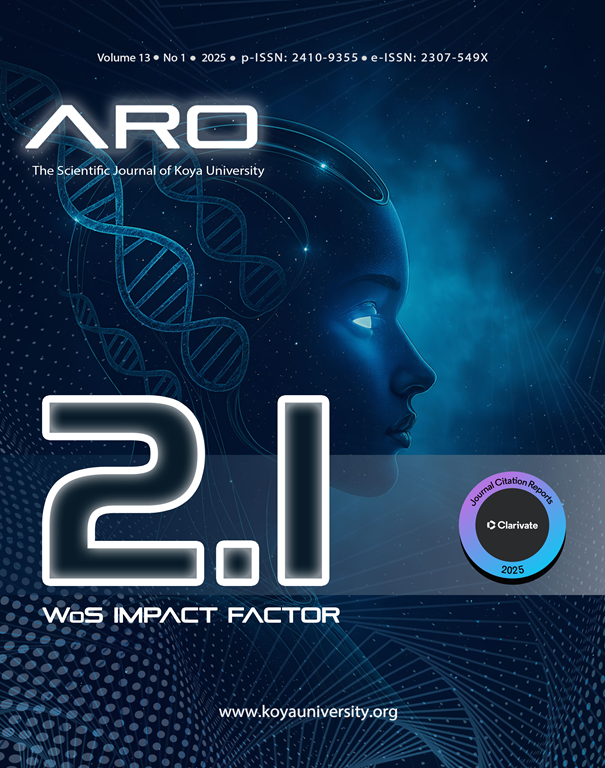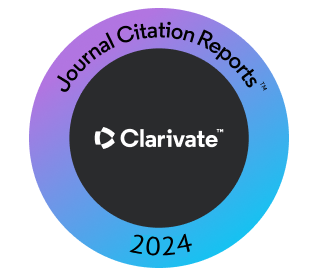Mechanical and Microstructure Characteristic of Oil- based Drilling Cuttings as Mineral Powder Substitute in Hot Mix Asphalt Mixture
DOI:
https://doi.org/10.14500/aro.12045Keywords:
Hot mix asphalt, Marshall stability, Mineral powder, Oil-based drilling cuttings, Scanning electron microscopeAbstract
Beyond the intensive worldwide oil wells drilling activities for seeking energy, the amount of oil-based drilling cuttings (OBDC) increased significantly, OBDC defined as a wasted drilling mud which is used in the drilling operation of oil wells. The OBDC falls under the category of hazardous waste that contains heavy metals and radioactive elements. In this study, OBDC was used as a substitute of mineral powder in hot mix asphalt. Various doses of OBDC (0%, 25%, 50%, 75%, and 100% by weight) were employed to replace the mineral powder. Marshall specimens were prepared to assess the physical characteristics and examine the microstructure. In results, by employing OBDC to 100%, The Marshall stability decreased from 12.1 kN to 9.22 kN, and flow value decreased from 3.96 mm to 3.3 mm compared to control specimen (0% of OBDC) due to the presence of uncoated and agglomeration of large amount of OBDC particle in bitumen constituent as examined by scanning electron microscope. Air voids increase from 3.9% to 4.26% and voids in mineral aggregates increase from 14.63% to 15.20% when mineral powder replaced by OBDC filler from 0% to 100%, respectively, due to the difference between the specific gravity of OBDC and mineral powder, in which higher percentage of OBDC leads to increase the porosity of the specimen. Utilizing 100% of OBDC instead of the mineral powder is compromised because the result falls within the standard ranges.
Downloads
References
Asphalt Institute., 1979. Mix Design Methods for Asphalt Concrete and Other Hot-Mix Types. Manual Series No. 2 (MS-2). Asphalt Institute, Lexington, KY.
ASTM., 1999. Standard Test Method for Ductility of Bituminous Materials. ASTM D113. ASTM, West Conshohocken, PA.
ASTM., 2002. Standard Test Method for Effect of Heat and Air on Asphaltic Materials (Thin-Film Oven Test). ASTM D1754. ASTM, West Conshohocken, PA.
ASTM., 2003. Standard Test Method for Specific Gravity and Density of SemiSolid Bituminous Materials (Pycnometer Method). ASTM D70. ASTM, West Conshohocken, PA.
ASTM., 2005. Standard Test Method for Penetration of Bituminous Materials. ASTM D5. ASTM, West Conshohocken, PA.
ASTM., 2006. Standard Test Method for Softening Point of Bitumen (Ring-andBall Apparatus). ASTM D36. ASTM, West Conshohocken, PA.
ASTM., 2007. Standard Test Method for Kinematic Viscosity of Asphalts (Bitumens). ASTM D2170. ASTM, West Conshohocken, PA.
ASTM., 2015. Standard Test Method for Marshall Stability and Flow of Asphalt Mixtures. ASTM D 6927. ASTM, West Conshohocken, PA.
ASTM., 2017. Standard Test Method for Sieve Analysis of Mineral Filler for Asphalt Paving Mixtures. ASTM D546. ASTM, West Conshohocken, PA.
ASTM., 2018. Standard Test Method for Flash and Fire Points by Cleveland Open Cup Tester. ASTM D92. ASTM, West Conshohocken, PA.
ASTM., 2020. Standard Practice for Preparation of Asphalt Mixture Specimens Using Marshall Apparatus. ASTM D6926. ASTM, West Conshohocken, PA.
ASTM., 2022. Standard Test Method for Effect of Heat and Air on a Moving Film of Asphalt Binder (Rolling Thin-Film Oven Test). ASTM D2872. ASTM, West Conshohocken, PA.
ASTM., 2022. Standard Test Method for Solubility of Asphalt Materials in Trichloroethylene or Toluene.
ASTM D2042. ASTM, West Conshohocken, PA.
Azadgoleh, M.A., Mohammadi, M.M., Ghodrati, A., Sharifi, S.S., Palizban, S.M.M., Ahmadi, A., Vahidi, E., and Ayar, P., 2022.
Characterization of contaminant leaching from asphalt pavements: Acritical review of measurement methods, reclaimed asphalt pavement, porous asphalt, and waste-modified asphalt mixtures. Water Research, 219, p.118584. DOI: https://doi.org/10.1016/j.watres.2022.118584
Bernardo, G., Marroccoli, M., Nobili, M., Telesca, A., and Valenti, G.L., 2007. The use of oil well-derived drilling waste and electric arc furnace slag as alternative raw materials in clinker production. Resources Conservation and Recycling, 52(1), pp.95-102. DOI: https://doi.org/10.1016/j.resconrec.2007.02.004
Cui, C., Yan, D., Liu, M., Wang, J., Li, L., Chen, C., and Huang, Q., 2023. Utilization of oil-based drilling cuttings as asphalt pavement surface: Study on the mechanical characteristics and long-term environmental impact. Environmental Technology and Innovation, 30, p.103052. DOI: https://doi.org/10.1016/j.eti.2023.103052
Ferrotti, G., Mancinelli, E., Passerini, G., and Canestrari, F., 2024. Comparison of energy and environmental performance between warm and hot mix asphalt concrete production: A case study. Construction and Building Materials, 418, p.135453. DOI: https://doi.org/10.1016/j.conbuildmat.2024.135453
Foroutan, M., Hassan, M.M., Desrosiers, N., and Rupnow, T., 2018. Evaluation of the reuse and recycling of drill cuttings in concrete applications. Construction and Building Materials, 164, pp.400-409. DOI: https://doi.org/10.1016/j.conbuildmat.2017.12.180
Gedik, A., Selcuk, S., and Lav, A.H., 2021. Investigation of recycled fluorescent lamps waste as mineral filler in highway construction: A case of asphaltic pavement layers. Resources Conservation and Recycling, 168, p.105290. DOI: https://doi.org/10.1016/j.resconrec.2020.105290
Hu, Y., Chen, X., Mu, S., and Li, Q., 2022. Extraction and separation of petroleum pollutants from oil-based drilling cuttings using methanol/n-hexane solvent. Process Safety and Environmental Protection, 168, pp.760-767. DOI: https://doi.org/10.1016/j.psep.2022.10.049
Huang, Z., Xu, Z., Quan, Y., Jia, H., Li, J., Li, Q., Chen, Z., and Pu, K., 2018. A review of treatment methods for oil-based drill cuttings. IOP Conference Series Earth and Environmental Science, 170, p.022074. DOI: https://doi.org/10.1088/1755-1315/170/2/022074
Hussein, N.S., and Ibrahim, R.K., 2023. Fresh and mechanical properties of concrete containing oil-well cutting material. ARO The Scientific Journal of Koya University, 11(1), pp.72-78. DOI: https://doi.org/10.14500/aro.10962
Ikotun, J.O., Okeniyi, J.O., Akinlabi, E.T., Akinlabi, S.A., Okeniyi, E.T., and Olanrewaju, D.O., 2019. Physicochemical and mineralogical characterization datasets from oil drill cuttings in comparison with other cement types for cement partial-replacement in concrete. Chemical Data Collections, 19, p.100176. DOI: https://doi.org/10.1016/j.cdc.2019.100176
Khan, D., Khan, R., Khan, M., Alam, M., and Hassan, T., 2023. Performance of hot-mix asphalt using polymer-modified bitumen and marble dust as a filler. Journal of Traffic and Transportation Engineering (English Edition), 10(3), pp.385-398. DOI: https://doi.org/10.1016/j.jtte.2022.12.002
Khodadadi, M., Moradi, L., Dabir, B., Moghadas Nejad, F., and Khodaii, A., 2020. Reuse of drill cuttings in hot mix asphalt mixture: A study on the environmental and structure performance. Construction and Building Materials, 256, p.119453. DOI: https://doi.org/10.1016/j.conbuildmat.2020.119453
Kumlai, S., Jitsangiam, P., and Nikraz, H., 2022. Assessments of moisture damage resistance of asphalt concrete mixtures and asphalt mastic with various mineral fillers. Transportation Engineering, 7, p.100106. DOI: https://doi.org/10.1016/j.treng.2022.100106
Mohammed, B., and Cheeseman, C.R., 2011. Use of oil drill cuttings as an alternative raw material in sandcrete blocks. Waste and Biomass Valorization, 2(4), pp.373-380. DOI: https://doi.org/10.1007/s12649-011-9089-z
Mostavi, E., Asadi, S., and Ugochukwu, E., 2015. Feasibility study of the potential use of drill cuttings in concrete. Procedia Engineering, 118, pp.1015- 1023. DOI: https://doi.org/10.1016/j.proeng.2015.08.543
Roberts, F.L., 1991. Hot Mix Asphalt Materials, Mixture Design, and Construction. National Asphalt Pavement Association, United States.
Siddique, S., Kwoffie, L., Addae-Afoakwa, K., Yates, K., and Njuguna, J., 2017. Oil based drilling fluid waste: An overview on environmentally persistent pollutants. IOP Conference Series Materials Science and Engineering, 195, p.012008. DOI: https://doi.org/10.1088/1757-899X/195/1/012008
Wang, C.Q., Lin, X.Y., He, M., Wang, D., and Zhang, S.L., 2017. Environmental performance, mechanical and microstructure analysis of concrete containing oil-based drilling cuttings pyrolysis residues of shale gas. Journal of Hazardous Materials, 338, pp.410-427. DOI: https://doi.org/10.1016/j.jhazmat.2017.05.051
Wang, X., Jin, W., Li, Y., Liu, S., Xu, J., Liu, J., Li, H., and Long, T., 2024. Treatment advances of hazardous solid wastes from oil and gas drilling and Production Processes. Chemical Engineering Journal, 497, p.154182. DOI: https://doi.org/10.1016/j.cej.2024.154182
Xie, B., Qin, J., Sun, H., Wang, S., and Li, X., 2021. Leaching behavior of polycyclic aromatic hydrocarbons (PAHs) from oil-based residues of shale gas drill cuttings. Environmental Pollution, 288, p.117773. DOI: https://doi.org/10.1016/j.envpol.2021.117773
Downloads
Published
How to Cite
Issue
Section
License
Copyright (c) 2025 Balen Z. Abdulsamad, Ameen A. Muhialdin, Tolaz S. Hawez, Rahel K. Ibrahim

This work is licensed under a Creative Commons Attribution-NonCommercial-ShareAlike 4.0 International License.
Authors who choose to publish their work with Aro agree to the following terms:
-
Authors retain the copyright to their work and grant the journal the right of first publication. The work is simultaneously licensed under a Creative Commons Attribution License [CC BY-NC-SA 4.0]. This license allows others to share the work with an acknowledgement of the work's authorship and initial publication in this journal.
-
Authors have the freedom to enter into separate agreements for the non-exclusive distribution of the journal's published version of the work. This includes options such as posting it to an institutional repository or publishing it in a book, as long as proper acknowledgement is given to its initial publication in this journal.
-
Authors are encouraged to share and post their work online, including in institutional repositories or on their personal websites, both prior to and during the submission process. This practice can lead to productive exchanges and increase the visibility and citation of the published work.
By agreeing to these terms, authors acknowledge the importance of open access and the benefits it brings to the scholarly community.
Accepted 2025-05-11
Published 2025-05-22
















 ARO Journal is a scientific, peer-reviewed, periodical, and diamond OAJ that has no APC or ASC.
ARO Journal is a scientific, peer-reviewed, periodical, and diamond OAJ that has no APC or ASC.